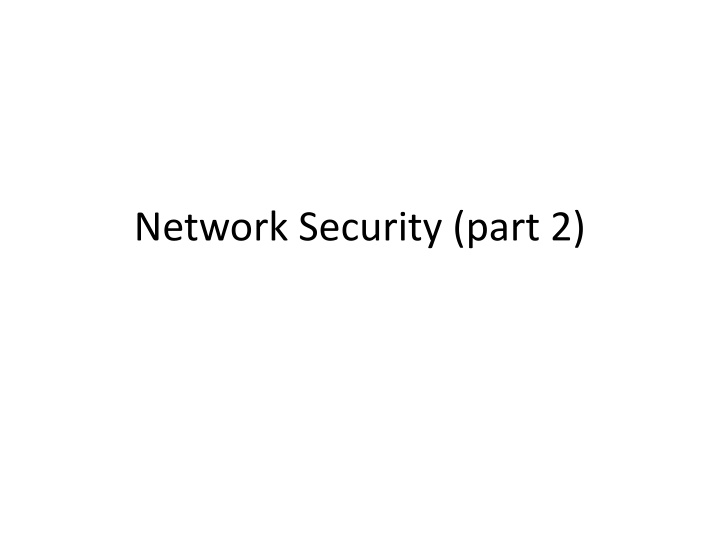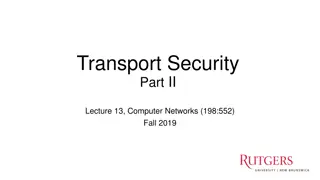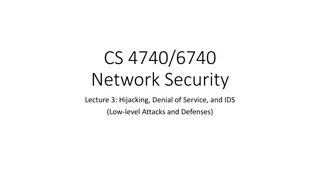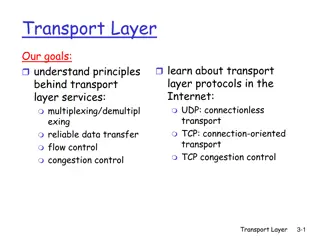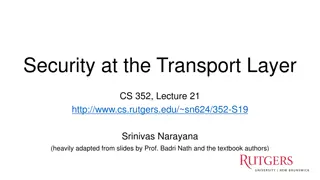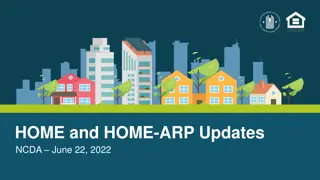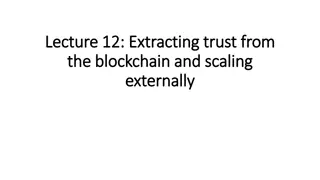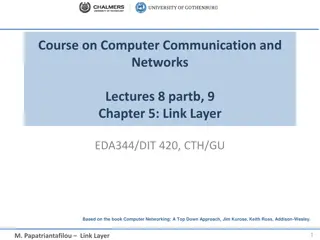Network Security Part 2: Link Layer and ARP
Exploring the vulnerabilities in simple network topologies with hubs and the need for examining the link layer to prevent eavesdropping. Dive into MAC addresses, ARP (Address Resolution Protocol), and how machines translate IP addresses to physical Ethernet addresses. Learn about ARP tables, the translation process, and how to view ARP data on different systems. Follow an ARP example illustrating how hosts communicate by resolving MAC addresses in a network.
Download Presentation

Please find below an Image/Link to download the presentation.
The content on the website is provided AS IS for your information and personal use only. It may not be sold, licensed, or shared on other websites without obtaining consent from the author.If you encounter any issues during the download, it is possible that the publisher has removed the file from their server.
You are allowed to download the files provided on this website for personal or commercial use, subject to the condition that they are used lawfully. All files are the property of their respective owners.
The content on the website is provided AS IS for your information and personal use only. It may not be sold, licensed, or shared on other websites without obtaining consent from the author.
E N D
Presentation Transcript
In our simple topologies from yesterday (generally built with hubs), there is nothing preventing a host from sniffing traffic intending for someone else.
We need to examine the link layer in order to better understand how to prevent eavesdropping. At the top end of the link layer, we can examine how machines address each other physically.
MAC addresses The MAC header contains the MAC address of the source and destination machine. (MAC address and ethernet address are interchangeable here.) They look like: 00-40-33-25-85-BB, or 00:40:33:25:85:BB
So, when a packet is translated from the internet (network) layer to the link layer, the machine must translate the destination IP address to a destination physical ethernet address.
ARP: Address Resolution Protocol This translation process is done via ARP. Each node in memory has an ARP table, which looks something like this:
Viewing ARP data On most systems (windows, linux, or mac), type arp a : Example (on my laptop): Macintosh:~ echambe5$ arp -a setup.ampedwireless.com;setup.ampedwireless.net (192.168.1.67) at f8:78:8c:0:1a:e6 on en0 ifscope [ethernet] ? (192.168.1.69) at 0:23:31:ee:37:56 on en0 ifscope [ethernet] ? (192.168.1.254) at 64:f:28:66:fc:c1 on en0 ifscope [ethernet] ? (192.168.1.255) at ff:ff:ff:ff:ff:ff on en0 ifscope [ethernet]
ARP Example First example: Host 1 transmits to host 2 No entry in the table. Host 1 broadcasts an ARP request on LAN 1. Essentially: If your IP is 133.176.8.57, then reply with your MAC.
ARP Example First example: Host 2 then replies with AB-49-9B-66-B2-69. The entry is added to ARP table, and transmission proceeds.
ARP Example Second example: Host 1 transmits to host 2 again. Entry is in the ARP table, so we use it. (If entry has changed, communication will fail and host 1 will try another ARP request.)
ARP Example Third example: Host 1 transmits to host 3 No entry in ARP table. Host 1 broadcasts an ARP request on LAN 1: if you IP is 133.176.8.222, then reply with your MAC address.
ARP Example Third example: Host 1 transmits to host 3 No reply is received. Host 1 then transmits a frame with destination IP address 133.176.8.222 and a source MAC address of AB-49-9B-25-B1-CA
ARP Example Third example: Host 1 transmits to host 3 The 2 port router gets the frame and sees the destination IP. Either it is in its ARP table, or it sends an ARP request on all ports.
Network devices Hubs, switches, and routers are all types of packet forwarding devices. A hub is a layer-1 device. That means it only has knowledge of the physical layer, so it sends all frames to all hosts. In essence, this means security is impossible.
Network devices Switches are layer-2 devices, so they live on the link level. This means they know about MAC addresses! So they can extract MAC addresses and only send the data to the target. Inherently more secure, since harder to sniff for traffic on the local network.
Network devices Routers live on layer 3, the actual network layer. They can: Perform like switches Forward frames across different kinds of networks Utilize NAT to hide IP addresses Forward frames across networks with different Net IDs. (Recall our IPv4 discussion last time.)
An attackers goal Given that switchers and routers provide much more secure transmission, an attackers goal is essentially to get these to behave more like hubs. We ll talk about a few common types of network attacks that essentially do this.
ARP Poisoing The goal is to convince the other computer that you are another IP (generally the default gateway), so that all traffic gets sent to you. Step 1: Send unsolicited ARP replies to fill up another machine s ARP table (so that it has to send ARP requests of its own) Step 2: Reply to those ARP requests with your own MAC.
ARP Poisoning There is no solid defense here, since ARP is inherently flexible. Possibilities: Extra software to check for possible spoofs Hard coded entries (but difficult to update) OS level guards (timeouts, ignore unsolicited ARPS, etc.) Note that there are legitimate uses! Page redirects, setting up redundancy, etc.
Implementing ARP Poisoning ARP Poisoning sets the network up for a man- in-the-middle attack: once you have everyone talking to your computer, you can intercept and modify traffic at will Tools: Here, we will use tcpdump to monitor traffic and ettercap to sniff and filter content from the network
Tcpdump Free linux command line tool that dumps all traffic from a network interface. Other tools do exist. Wireshark, for example, is a free graphics based client much like tcpdump. Must be run as root (or admin privileges). With a hub (or wireless network), will see all traffic; on a switched network, will see all traffic routed to your machine Good tutorial: http://danielmiessler.com/study/tcpdump
Ettercap Multipurpose sniffer and content filter for network management (i.e. man-in-the- middle attacks). See http://linux.die.net/man/8/ettercap You can use ettercap simply to sniff, but also to automatically apply filters to content being sent.
Ettercap example 1: Observe traffic between two machines
Ettercap example 2: Alter web traffic Step 1: write a filter and compile it.
Ettercap example 2: Alter web traffic Step 2: run ettercap
Beyond ARP poisoning Once you have the basic setup, still need to conduct man-in-the- middle attack ARP poisoning lets you eavesdrop, but what if the traffic is encrypted?
Recall: Key exchanges Simple protocol: Alice sends her public key to Bob. Bob sends his public key to Alice. Alice encrypts message with Bob s public key, so Bob can decrypt with his private key. Bob encrypts with Alice s public key, and she can then decrypt with her own private key.
Recall: Key exchanges Exploiting the simple protocol: When Alice sends her public key to Bob, Eve intercepts and sends along her own public instead. (Likewise for Bob s public key.) When Alice sends a message to Bob, Eve is able to decrypt it. She can then send it along to Bob (encrypted with her own key, which Bob thinks is Alice s), or can replace it with a new one. (Likewise for a message from Bob to Alice.)
Avoiding this attack Simple key exchange: A common cryptographic technique is to encrypt each individual conversation with a session key. --Applied Cryptography by Schneier Alice gets Bob s public key from a distribution center Alice generates a random session key, encrypts it with Bob s public key, and sends it. Bob decrypts Alice s message using his private key Both can then use the session key to encrypt.
Note: still not foolproof! At Black Hat DC 2009, for example, Moxie Marlinspike announced a security hold in one kind of certificate used I the SSL and TSL protocols. His attack adds a null string character to a certificate field, which tricks the programs into recognizing a domain (incorrectly).
SSLstrip He developed and now distributes a tool called SSL strip essentially a simple python script to install the tool. See the download page for details: http://www.thoughtcrime.org/software/sslstri p/ Given this (and other known issues), many think SSL has deep flaws in its structure, although it continues to be the industry leader.
Network Design: A Case Study Independent of all these low level (and important issues), it may still be up to you to design a network for a corporation. Infrastructure requirements and goals are a key point of the design: Data should be confidential, and internal plans kept secret. Releasing sensitive data should require approval.
Policy Design and Development Goal is to develop security policies Examine: Internal organizations Data classes User classes Infrastructure options or limitations
First principles: Principle of Least Privilege: A subject should be given only those privileges that it needs to complete its task. Principle of Open Design: The security of a mechanism should not depend on the secrecy of its design or implementation.
First principles: Principle of Separation of Priviledge; The system should not grant permission based on a single condition. Principle of Fail-Safe Defaults: Unless a subject is given explicit access to an object, it should be denied access.
Network Design Fundamentals Most large scale networks have a Demilitarized Zone (DMZ): A separate network between the purely internal network and the actual external internet Two firewalls (one on each end), each with different sets of rules Very few machines present; this is a place for services that need external access regularly, but actual workstations don t fall into this category
The outer firewall Goals of the outer firewall: No read up : restrict public access to the corporate network, which has sensitive data they do not have rights to access. No write down : Restrict Dribble employee s access to the internet, so that they cannot share sensitive data outside the company.
The outer firewall Here, the company has decided that the outside network only needs access to the web server and the mail server.
The inner firewall This firewall will block ALL traffic except: SMTP connections (although all electronic mail goes through DMZ server) System admins may access the DMZ computers from a trusted server only
Administrator connection Uses SSH protocol Inner firewall ensures that SSH can only go to the DMZ servers SSH is set up at a trusted machine, so that we can ensure strong cryptographic authentication at both endpoints
